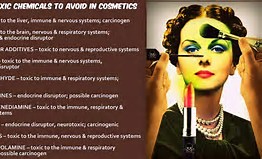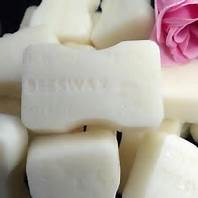Beauty at the Expense of the Environment





Cosmetics and toiletries, like other consumer products, contain ingredients that can persist in the environment and bioaccumulate in our bodies and other living organisms. Let's take a close look at some of the chemicals found in our cosmetics that are now present in the environment to an alarming degree.
TRICLOSAN
Triclosan is found in many common household products including washing-up liquid, toothpastes, hand washes, soaps and other cosmetic products. An estimated 60-90 tonnes of this substance are released into the UK environment each year, the majority of it is heading straight for the sewers. Most of it is removed prior to the effluent being discharged back into the environment, but some still remains. Triclosan can degrade into the persistent metabolite methyl triclosan, which bioaccumulates in fish, triclosan can also degrade under sunlight to produce a form of dioxin.
SYNTHETIC MUSK
Synthetic musks man-made chemicals commonly used in a range of fragranced consumer products, including laundry detergents, air-freshners, household cleaners, perfumes, aftershaves, cosmetics and personal care products, are persistent environmental contaminants that have been detected in rivers, lakes, sediment, soil ,sewage, sludge and effluent from waste water treatment plants in the UK, Canada, the US and Europe. Although produced to replace natural musks derived from musk deer and musk ox, synthetic musks are not structurally similar and behave more like polychlorinated biphenyls (PCBs) and organochlorine pesticides. increasing in concentration as they move higher up the food chain. Due to the prolific use of synthetic musk in consumer items they have also been identified in the atmosphere, both indoors and outdoors. All synthetic musks have been shown to possess oestrogenic and anti-oestrogenic properties. Many retailers are discontinuing their use.
PHTHALATES
Commonly used in cosmetic products are plasticizers and solvents, phthalates are the most abundant synthetic chemicals in the environment. They are ubiquitous environmental contaminants that are deemed to be hazardous waste and regulated as pollutants when released into the environment by industry. Phthalates have been detected in rainwater, water, soil, sediments, indoor air and dust, fish/marine food webs, meat, dairy products, human blood and breast milk. Phthalate metabolites have also been identified in the urine of adults and children. Analyses of wastewater from residential, commercial and industrial sites in the San Francisco Bay area by the Environmental Working Group (EWG) and East Bay Municipal Utility District (EBMUD) detected, in 18 out of 19 wastewater samples evaluated, at least one of the three unregulated and commonly used hormone disruptors - phthalate, bisphenol air and seawater samples, although the concentrations detected were low.
PERFLUORINATED CHEMICALS (PFCs)
Perfluorinated chemicals (PFCs), a group of fluorine-containing chemicals used for their heat-stable properties and ability to resist degradation and repel water and oil, can be found in a host of applications, including non-stick coatings for kitchenware, stain - and water-repellent treatment for carpets, paper coatings, surfactants, furniture and clothing, floor polishes, cleaning products, shampoo and food packaging materials. PFCs are persistent and bioaccumulative contaminants. Perfluorooctane surfactants have been detected in living organisms, water and air samples from geographic locations in the North American Artic collected between 1972 and 2002, detected levels of perfluorooctane sulfonate (PFOS) and perfluorocarboxylic acids (PFOAs).
ALKYLPHENOLS (APs)
Alkyllphenols (APs) are the breakdown products of alkylphenol ethoxylates (APEs) and are toxic to aquatic organisms and potent endocrine disruptors. Although APEs were phase out of domestic detergents in the 1970s, they are still used in various other consumer products including shampoos and shaving foams, and they break down into ecologically hazardous APs such as nonylphenol (NP) and octylphenol (OP) after being discharged into sewage treatment plants or undergoing environmental processes. Once discharged from treatment plants they are disseminated into the environment via effluent discharge into surface waters and sludge disposal on lands.
- The breakdown products of APE are approximately ten times more toxic than the original compounds. In one study on sea urchin embryos. NP and Op were shown to cause malformationm in the skeletal system at low concentrations, while high concentrations hindered the growth of the embryos. Dr Christian Daughton and Dr Thomas Ternes of the US Environmental Protection Agency explains in a special report published in the scientific journal Environmental Health Perspectives that personal care products are constantly entering the environment through sewage treatment facilities and where untreated sewage is discharged directly in rivers, products and pharmaceuticals may be more chronic than exposure to pesticides because they are constantly introduced into the environment in places where humans reside and visit.
- TAKE HOME MESSAGE
We are powerful as consumers. The products we use, even in small amounts, have a measurable effect on the environment. Choose all your household products- personal care and cleaning - according to their kindness to the environment. And, reduce packaging as much as you can. Choose glass containers where possible and seek out manufacturers who encourage refills of containers.
- Reference: Toxic Beauty: Dawn Mellowship
Articles-Latest
- Skin tags: Why they develop, and how to remove them
- So That’s Why Your Skin Gets Crepey As You Get Older
- Eye Infection from False Eyelashes
- Teeth stain removal and whitening solutions
- Benefits of collagen for skin
- Why vitamin E should be part of your skincare regime
- Can gray hair be reversed?
- Hair loss affects 1 in 10 women before the menopause – here’s how to treat it
- Conscious ageing and Black skin: What happens when Black does crack?
- Your skin color may affect how well a medication works for you — but the research is way behind
- The C word Cancer
- Astringents
- How does light therapy work? The science behind the popular skincare treatment
- The Most Offensive Fashion Police Criticisms of All Time
- Everything you need to know about lip filler migration, as told by the experts
- Pig semen and menstrual blood – how our ancestors perfected the art of seduction
- Everything you need to know about benzoyl peroxide
- We've bleached, relaxed, and damaged our hair to make ourselves look more white
- Will this be the year that facial filler is cancelled?
- Shock of the old: 10 painful and poisonous beauty treatments
Cosmetic ingredients
LOGIN
Who's On Line
We have 44 guests and no members online
Articles-Most Read
- Home
- White Bees Wax
- Leucidal
- Cosmetic Preservatives A-Z
- Caprylyl Glycol
- Cosmetics Unmasked - How Safe Are Colorants?
- Cosmetics Unmasked - Choosing Ingredients
- Cosmetics Unmasked - Colorants And Fragrances
- EcoSilk
- Toxic Beauty - Who's Looking At Cosmetics?
- Cosmetics Unmasked - Fragrances
- Microbes and Cosmetics
- Chemicals Lingering In The Environment
- Yellow Bees Wax
- Microbes and Safety Standards
- Potassium Sorbate
- Toxic Beauty - Hazardous To Your Health
- Synthetics In Cosmetics - The Industry Fights Back
- What's Happening in the USA - Cosmetic Regulations - Toxic Beauty
- Fresh Goat's Milk Soap
- Active Ingredients
- Cosmetics Unmasked - Listing Cosmetics
- Toxic Beauty - Cocktails and Low Doses
- Natural Waxes A-Z
- Natural Butters A-Z



